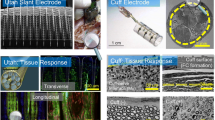Abstract
The ability to interface electronic materials with the peripheral nervous system is required for stimulation and monitoring of neural signals. Thus, the design and engineering of robust neural interfaces that maintain material-tissue contact in the presence of material or tissue micromotion offer the potential to conduct novel measurements and develop future therapies that require chronic interface with the peripheral nervous system. However, such remains an open challenge given the constraints of existing materials sets and manufacturing approaches for design and fabrication of neural interfaces. Here, we investigated the potential to leverage a rapid prototyping approach for the design and fabrication of nerve cuffs that contain supporting features to mechanically stabilize the interaction between cuff electrodes and peripheral nerve. A hybrid 3D printing and robotic-embedding (i.e., pick-and-place) system was used to design and fabricate silicone nerve cuffs (800 µm diameter) containing conforming platinum (Pt) electrodes. We demonstrate that the electrical impedance of the cuff electrodes can be reduced by deposition of the conducting polymer poly(3,4-ethylenedioxythiophene) polystyrene sulfonate (PEDOT:PSS) on cuff electrodes via a post-processing electropolymerization technique. The computer-aided design and manufacturing approach was also used to design and integrate supporting features to the cuff that mechanically stabilize the interface between the cuff electrodes and the peripheral nerve. Both ‘self-locking’ and suture-assisted locking mechanisms are demonstrated based on the principle of making geometric alterations to the cuff opening via 3D printing. Ultimately, this work shows 3D printing offers considerable opportunity to integrate supporting features, and potentially even novel electronic materials, into nerve cuffs that can support the design and engineering of next generation neural interfaces.
Similar content being viewed by others
References
S. V. Murphy and A. Atala, Nat. Biotech. 32, 773–785 (2014).
Y. L. Kong, M. K. Gupta, B. N. Johnson, and M. C. McAlpine, Nano Today 11, 330–350 (2016).
E. Macdonald, R. Salas, D. Espalin, M. Perez, E. Aguilera, D. Muse and R. B. Wicker, IEEE Access 2, 234–242 (2014).
B. N. Johnson, K. Z. Lancaster, G. Zhen, J. He, M. K. Gupta, Y. L. Kong, E. A. Engel, K. D. Krick, A. Ju, F. Meng, L. W. Enquist, X. Jia, and M. C. McAlpine, Adv. Funct. Mater. 25, 6205–6217 (2015).
B. N. Johnson, K. Z. Lancaster, I. B. Hogue, F. Meng, Y. L. Kong, L. W. Enquist, and M. C. McAlpine, Lab Chip 16, 1393–1400 (2016).
M. Singh, Y. Tong, K. Webster, E. Cesewski, A. P. Haring, S. Laheri, B. Carswell, T. J. O’Brien, C. H. Aardema, R. S. Senger, J. L. Robertson, and B. N. Johnson, Lab Chip 17, 2561–2571 (2017).
A. P. Haring, H. Sontheimer, and B. N. Johnson, Stem Cell Rev. Rep., 13, 381–406 (2017).
A. P. Haring, A. U. Khan, G. Liu, and B. N. Johnson, Adv. Opt. Mater. 5, 1700367 (2017).
M. K. Gupta, F. Meng, B. N. Johnson, Y. L. Kong, L. Tian, Y.-W. Yeh, N. Masters, S. Singamaneni, and M. C. McAlpine, Nano Lett. 15, 5321–5329 (2015).
H.-W. Kang, S. J. Lee, I. K. Ko, C. Kengla, J. J. Yoo, and A. Atala, Nat. Biotech. 34, 312–319 (2016).
Y. L. Kong, I. Tamargo, H. Kim, B. N. Johnson, M. K. Gupta, T.-W. Koh, H.-A. Chin, D. A. Steingart, B. P. Rand, and M. C. McAlpine, Nano Lett. 14, 7017–7023 (2014).
B. N. Johnson and X. Jia, Neural Regen. Res. 11, 1568–1569 (2016).
C. J. Pateman, A. J. Harding, A. Glen, C. S. Taylor, C. R. Christmas, P. P. Robinson, S. Rimmer, F. M. Boissonade, F. Claeyssens, and J. W. Haycock, Biomaterials 49, 77–89 (2015).
R. Lozano, L. Stevens, B. C. Thompson, K. J. Gilmore, R. Gorkin Iii, E. M. Stewart, M. in het Panhuis, M. Romero-Ortega, and G. G. Wallace, Biomaterials 67, 264–273 (2015).
K. A. Ludwig, J. D. Uram, J. Yang, D. C. Martin, and D. R. Kipke, J. Neural Eng. 3, 59–70 (2006).
X. Cui and D. C. Martin, Sens. Actuators B 89, 92–102 (2003).
S. J. Wilks, A. J. Woolley, L. Ouyang, D.C. Martin, and K. J. Otto, Conf. Proc. IEEE Eng. Med. Biol. Soc., 5412–5415 (2011).
Author information
Authors and Affiliations
Corresponding author
Rights and permissions
About this article
Cite this article
Tong, Y., Murbach, J.M., Subramanian, V. et al. A Hybrid 3D Printing and Robotic-assisted Embedding Approach for Design and Fabrication of Nerve Cuffs with Integrated Locking Mechanisms. MRS Advances 3, 2365–2372 (2018). https://doi.org/10.1557/adv.2018.378
Published:
Issue Date:
DOI: https://doi.org/10.1557/adv.2018.378




